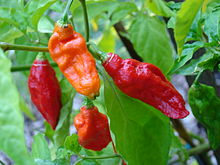Scoville scale



The Scoville scale is a measurement of pungency (spiciness or "heat") of chili peppers and other substances, recorded in Scoville heat units (SHU). It is based on the concentration of capsaicinoids. Capsaicin is the main thing measured.[3]
The scale is named after its creator, American pharmacist Wilbur Scoville.[3][4] The Scoville organoleptic test is a subjective assessment derived from the capsaicinoid sensitivity by people experienced with eating hot chilis.[3]
An alternative method, high-performance liquid chromatography, can be used to analytically quantify the capsaicinoid content as an indicator of pungency.[3][5]
Scoville organoleptic test
[change | change source]In the Scoville organoleptic test, an exact weight of dried pepper is dissolved in alcohol. This extracts the heat components, the capsaicinoids. They are then diluted in a solution of sugar water.[3][6] Decreasing concentrations of the extracted capsaicinoids are given to a panel of five trained tasters, until a majority (at least three) can no longer detect the heat in a dilution.[1][3][6] The heat level is based on this dilution, rated in multiples of 100 SHU.[6]
Capsicum chili peppers are used to add pungency in food.[3] The range of pepper heat reflected by a Scoville score is from 500 or less (sweet peppers) to over 2.6 million (Pepper X) .
References
[change | change source]- ↑ 1.0 1.1 Barry-Jester, Anna Maria (October 15, 2014). "Rating Chili Peppers On A Scale Of 1 To Oh Dear God I'm On Fire". FiveThirtyEight. Retrieved 2014-11-02.
- ↑ "Some Like It Hot: Dorset's Ultra-Hot Chillies". Archived from the original on 19 November 2012. Retrieved 25 August 2010.
- ↑ 3.0 3.1 3.2 3.3 3.4 3.5 3.6 Twilight Greenaway (10 January 2013). "How Hot is That Pepper? How Scientists Measure Spiciness". Smithsonian.com, US Smithsonian Institution. Retrieved 17 December 2017.
- ↑ Scoville, Wilbur (May 1912). "Note on Capsicums". Journal of the American Pharmaceutical Association. 1 (5): 453–454. doi:10.1002/jps.3080010520.
- ↑ Al Othman, Zeid Abdullah (2011). "Determination of Capsaicin and Dihydrocapsaicin in Capsicum Fruit Samples using High Performance Liquid Chromatography". Molecules. 16 (10): 8920. doi:10.3390/molecules16108919. PMC 6264681. PMID 22024959.
- ↑ 6.0 6.1 6.2 Peter, K. V. (2012). Handbook of Herbs and Spices. Elsevier Science. p. 127. ISBN 978-0-85709-5671.
